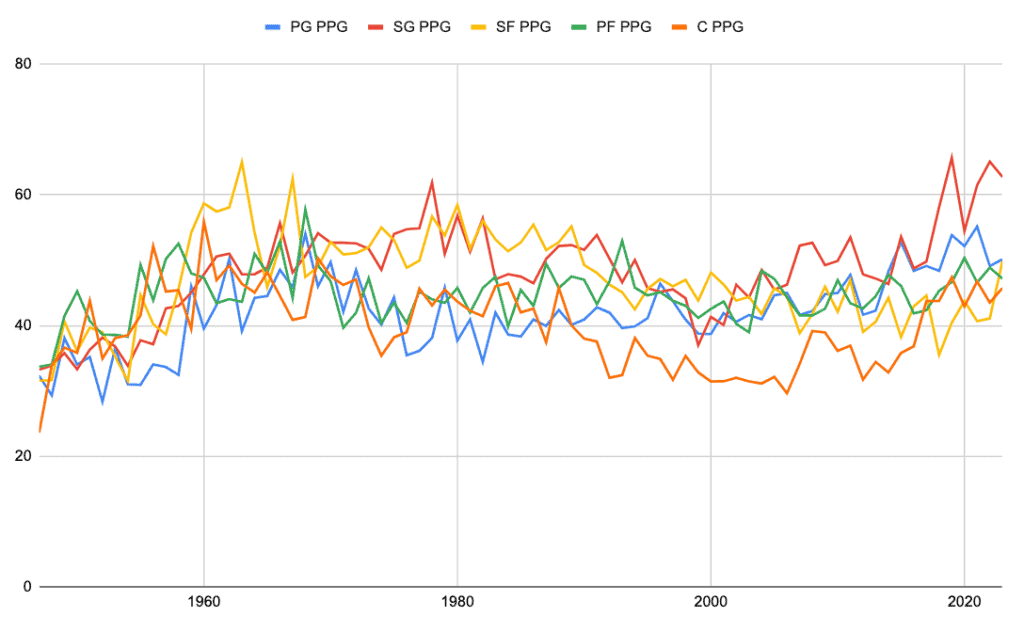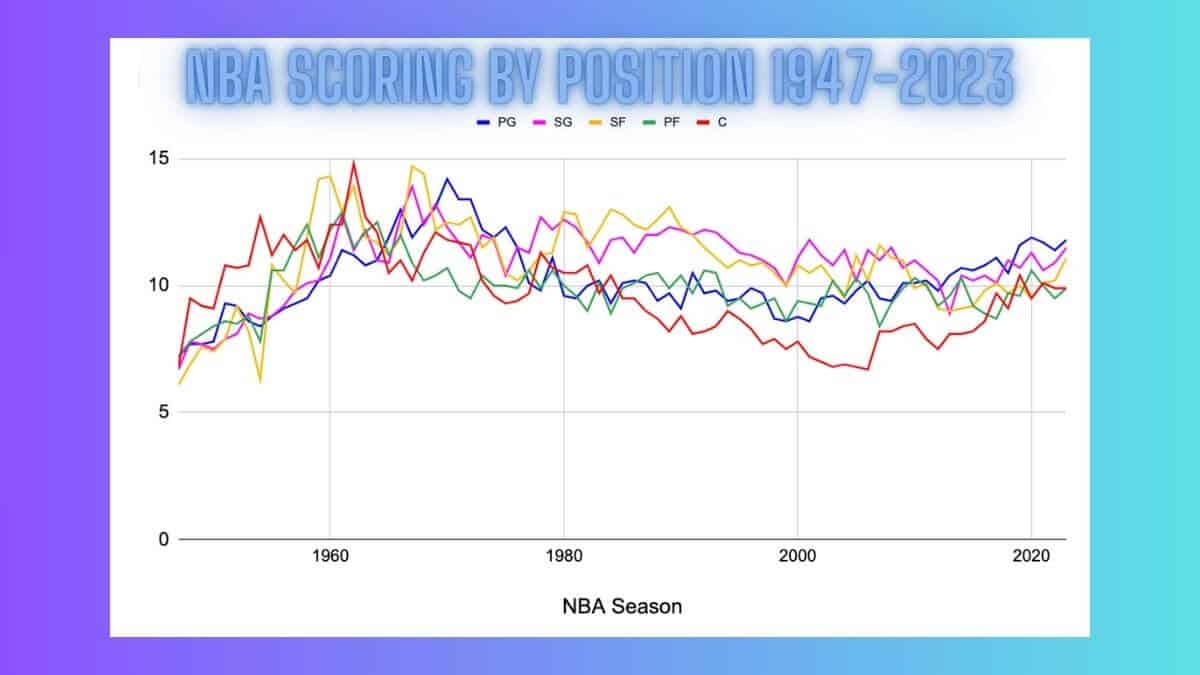It’s widely understood that, in the past 20 years or so, NBA scoring has shifted to the perimeter. But I got to thinking. What effect, if any, has this trend had on NBA scoring by position? If guards take more 3’s, are they pulling points away from the backcourt? How much point share has the Center really lost?
So Here’s a plot of NBA scoring by position, from 1947 to 2023.
Click the graph if you want the interactive version.

When I first sourced the data for this, I was going off of StatMuse. However, with some help from Redditors, I realized my data was incorrect. The data was labeled as PPG by position, but it seems like it may have been the average PPG by position. But after doing some checks, I’m not even sure that’s correct. Either way, to fix my graph, I had to write a web scraper to pull data out of the player stats at basketball-reference.
It was a pain, but the data is much more reliable. I added up total minutes for each position and divided by the number of games played in the regular season of that year. If a player was listed under multiple positions, I divided their minutes evenly across those positions.
So the resulting data is the average points per game coming from any player in a corresponding position. That is, the average PPG of any player on the court, playing for either team, who is listed as playing in that position.
A little confusing I guess, but it should make sense.
So what do we see in the data?…
First of all, keep in mind that this data can’t account for all of the subtle variations in position that occur over time. Today’s NBA tends to be extremely flexible, with players falling into more hybridized roles on the court. Still, there’s some really interesting stuff that comes up in the graph.
The Overall Path of NBA Scoring
We see a collective peak in the early-60’s and a dip in the 2000’s. Since that time, overall scoring has been trending upward.
It’s important to note here that field goal percentage in the 40’s and 50’s was trash. I tend to believe those early years are attributable to a general lack of skill. Early pros didn’t really know how or when to shoot in comparison to later generations.
By the 70’s, we had figured it out. As professional basketball evolved into a life-altering career path, competition naturally increased. There was a recalibration of the base-level human ability to put a ball in a net.
Now, I doubt highly that offensive skill fell off in the mid-70’s as you might infer from the long dip in the middle of the graph. Rather, I tend to think that a combination of rules adjustments and defensive improvements led to an overall decrease in scoring.
The Importance of the Center
One thing I kinda expected to see from all of this was high productivity from the 5. That’s not exactly the case. Centers ate pretty well in the beginning. When you scan early stats, George Mikan was an absolute beast. But any reliance on the 5 seems to have fallen off by the 70’s. And through the 90’s and 2000’s, the center remained the lowest scoring position.
The Dominance of the Wing
For the vast majority of the 30 years between 1970 and 1990, the lion’s share of points went to the wings. Check the grouping for that time period. Wings at the top, everyone else grouped around the bottom. Overall, scoring on a slight downward trend.
So, for a solid 30 years there, the ball was getting dished off to a shooting guard or a small forward. And for many of those years, the vast majority of the resulting shots were from mid-range.
The Rise of the Guard
I find it particularly interesting that the point guard follows a similar path to the center, peaking early on and sliding into a long, low trough. The big difference though, the guards have been crushing it since the 2010’s.
I find this really interesting. Theoretically, the point guard should be a facilitator. But apparently, the modern scoring point guard is more than a myth. The point guard has spent a good chunk of the past decade near the top of the scoring hierarchy.
The shooting guard is more dominant than ever before. But the other positions are pretty well-balanced currently.
The Introduction of the Shot Clock
The NBA adopted the shot clock in 1954 in an effort to increase scoring and reduce incentives to just burn out the clock. It seems to have worked.
There’s a pretty sharp uptick across the board after 1954. While the league was already on a scoring uptrend, the shot clock definitely gave it fuel.
Fans approved widely, and the system exists in most leagues today. Who wants to see a game of keep-away anyway?
The Introduction of the 3-point Line
1980 marked the introduction of the 3-point line to the NBA. You’d almost expect a scoring uptick from the wings. But nobody used the arc much for at least a decade.
What we see instead is a slow decline in scoring from the wings, leading into that brief little bump for the power forward. 1983 really seems to have been the year of the power forward. The position has had its moments, but never sustained. It’s interesting, I’m going to have to look into that a little more.
Today’s Game
So here we are in the 2020’s. This guy who played in the 90’s, one of the most efficient 3-point marksman in NBA history, on the most dominant team in the NBA, under the most dominant offensive philosophy in NBA history, he started coaching.
And his coaching philosophy seems to at least partially have been rooted in the idea of what if he was even more accurate at the arc, and what if he could just take all of the shots he ever wanted.
And yeah, Kerr didn’t do it alone, not at all. And he’s been taking some serious flak for his unwavering commitment to small ball with Team USA. But if you’re in the NBA and you’re not running some kinda motion concept, and you’re not knocking down 3’s, you’re not doing it right.
Take a look at the last leg of that graph. There’s been a lot going on in the league in the last decade, but 2014 is the year Steve Kerr started coaching the Warriors. In 2015, they won a title.
It’s no secret that the recipe worked, and it’s safe to say that other teams in the league picked up on it. Play-making guards are in. Perimeter scoring is definitely in. The big as a mobile threat, but primarily defensively, that’s kinda in too.
Takeaways
In some ways, I expected to see stronger evidence of the modern evolution of NBA play. In my mind, the narrative has largely been that, prior to the 90’s and definitely prior to 2010, the big was king.
The truth is a subtler transition, adjustments in skill and technique over time, as well as direct changes to the rule book. Not to mention a massive era where the wings were the dominant scorers.
There have been times in history where the game has become a drag-out fight in the paint. The ultimate response to that is generally a surgical attack from the outside. Each generation influences the next generation, and in ways the newer generation will always rebel.
There’s no telling for sure where we go next, but we do know that overall scoring can’t keep going up forever. We’re also starting to see a bit of an interest in less traditional defenders. Guys like Jaren Jackson Jr. are chasing blocks and steals over rebounds. Dudes like Wembanyama are pushing the envelope of what you can expect of biology and skill. And Jokić is running the floor at an elite level from the post.
Over time, the landscape will shift. Give it 10 years and we might just see the bigs make a comeback, probably with one of those little spikes for the 4. We might be seeing it already. Give Aaron Gordon one more season.
